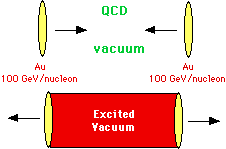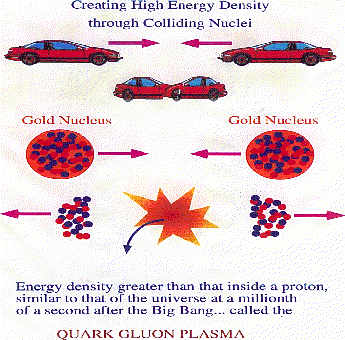|
Overview of Project
Brookhaven Info
Contacting Collaboration
Schedules
Pictures
Publications
Presentations
Computing
Phobos Twiki
New: HI
Collision Animations
Mirror sites
Copyright 2006 by the Phobos Collaboration. All rights reserved.
Contact webmaster with
questions or comments.
|
|
The Physics
Background for non-scientists.
Physicists have overwhelming evidence
that nuclear matter is made of point-like quarks and
gluons, but no one has ever seen a free quark or gluon.
The quarks and gluons seem to be confined inside hadrons
such as protons and neutrons. Inside these entities the
quarks and gluons behave as free particles. It is part of
the theory called Quantum Chromo Dynamics (QCD). It is a
consequence of the properties of empty space, i.e. of the
vacuum. By compressing nuclei so that individual protons
and neutrons overlap or dump an enormous amount of energy
into a very small volume, it should be possible to create
a much greater volume in which there are free quarks and
gluons. This state is called a Quark-Gluon Plasma (QGP).
If physicists can create it, the study of QGP should cast
light on QCD and the problem of confinement.
If physicists are able to create a QGP it will expand and
decay into hadrons (strongly interacting particles such
as protons, neutrons, and pions) and will recreate the
scenario that occurred at about a micro-second after the
Big Bang. At that time the energy which is inside our
present universe occupied a volume of about the size of
our solar system. It consisted entirely of the QGP at a
temperature of about 1,000,000,000,000 degrees. It was
rapidly expanding and cooling. Suddenly the temperature
fell below a critical value and a phase transition
occurred. This process is analogous to droplets forming
in cooled steam. For the first time in the history of the
universe, nuclear matter (protons, neutrons, etc.) was
created. Recreating and studying the process, even on a
very small scale, may teach physicists something about
the evolution of the universe.
As a by-product, the study of the QGP may also give
scientists information about the properties of the
vacuum. The present understanding of the vacuum is that
it is anything but empty. It is full of fluctuations;
particles are appearing and disappearing. The vacuum can
be characterized by the type of fluctuations that occur.
Theorists have speculated that following the decay of a
QGP, occasionally a different state of the vacuum might
be produced.

How will the Quark Gluon Plasma be created and studied?
The cartoon below illustrates how it might be possible to
create the QGP. Scientists believe that if nuclei are
accelerated to velocities which are very close to the
speed of light, and then made to collide head-on, they
will either be compressed sufficiently or dump enough
energy in a small volume to produce the QGP.

Facilities have been built in the US and Europe to
accelerate nuclei to higher and higher velocities and to
study these collisions. To date, there is no clear
evidence of the creation of a QGP.
With the completion of the construction of Relativistic
Heavy Ion Collider (RHIC) in 1999 a major advance will
occur. The collider will accelerate gold in two separate
rings which will circulate in opposite directions around
a pair of superconducting magnet rings in a tunnel 3.8
kilometers in circumference. The gold nuclei will reach
speeds which are equal to 99.995% of the speed of light,
and in their collisions energy densities will be produced
equivalent to the mass of the earth in volume 10 x 10 x
10 meters.
The gold nuclei will be made to collide at four locations
around the rings. Here sophisticated detectors will be
placed to examine the consequences of the collisions.
Since the precise outcome of these collisions is not
known, each detector is optimized to be sensitive to
different possible outcomes. One of the four detectors is
called Phobos.
An Overview of Phobos
The Phobos concept is based on the
premise that interesting collisions will be rare but that
when they do occur the new physics will be readily
identified. Thus the Phobos detector is designed to be
able to examine and analyze a very large number of
unselected gold-gold collisions. For each collision the
detector gives a global picture of the consequences of
the collision and detailed information about a small
subset of the nuclear fragments ejected from the high
energy density region.
The PHOBOS Detector
PHOBOS consists of many silicon detectors
surrounding the interaction region. With these detectors
physicists will be able to count the total number of
produced particles and study the angular distributions of
all the products. With this array they will be on the
look out for unusual events, fluctuations in the number
of particles and angular distribution. Physicists know
from other branches of physics that a characteristic of
phase transitions are fluctuations in physical
observables. In order to obtain more detailed information
about these events the PHOBOS detector will also have two
high quality magnetic spectrometers which will study, in
detail, 1% of the produced particles.
The PHOBOS detector will be able to measure quantities
such as the temperature, size, and density of the
fireball produced in the collision. It will also study
the ratios of the various particles produced. With this
information it should be possible to both detect and
study a phase transition that might occur between QGP and
ordinary nuclear matter. With PHOBOS, the group hopes to
discover the QGP and learn more about confinement and the
early universe.
|